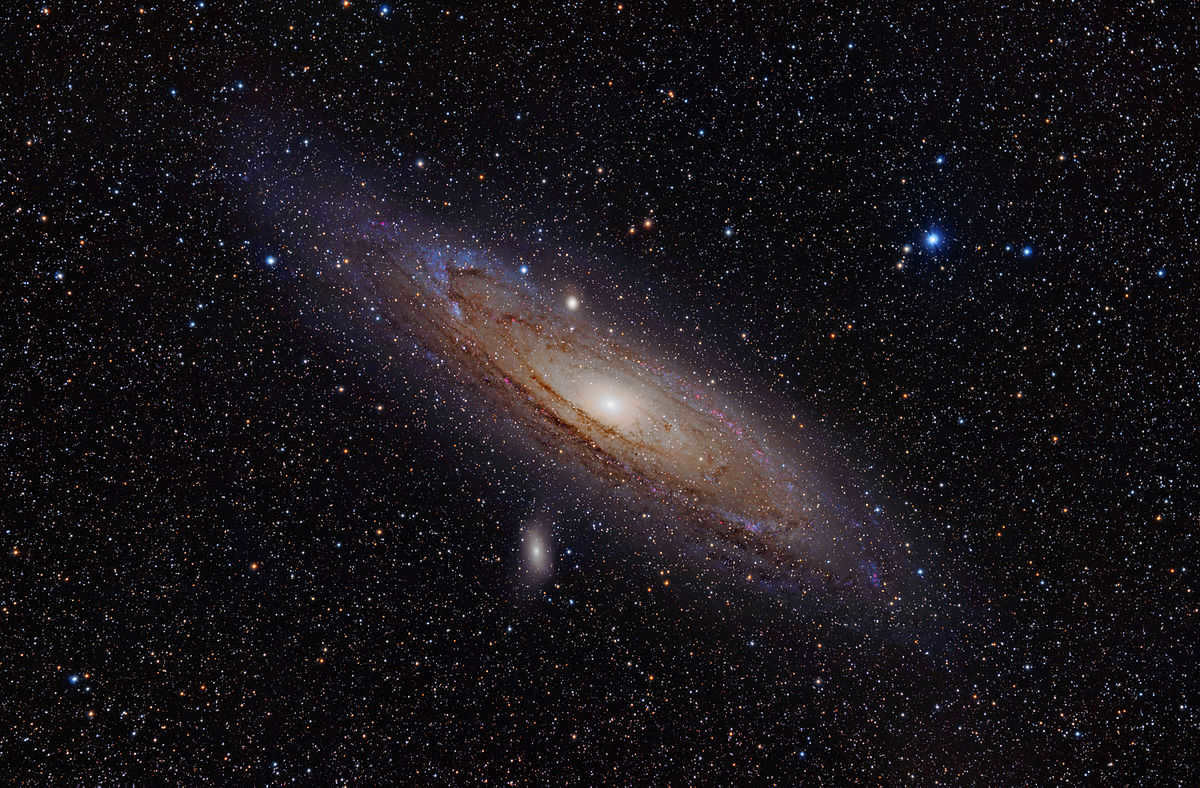
The Andromeda galaxy M31 holds the title for being the farthest object in space that can be seen with the naked eye. It is also the closest galactic object to our own Milky Way. This massive galaxy is on a collision course with our galaxy and will eventually merge with it in a couple billion years. The Andromeda galaxy M31 was the first outer galaxy ever discovered, making it a significant landmark in the exploration of the Universe. It has been extensively studied and remains one of the most well-documented galaxies.
Key Features of Andromeda
Andromeda, previously referred to as the Andromeda Nebula or M31 in the well-known Messier catalog, is a spiral galaxy that holds significant scientific importance. It is renowned as one of the prominent “star islands” and has captured the attention of astronomers worldwide. One of the remarkable aspects of Andromeda is the ability to observe millions of individual stars, even with high-powered telescopes. Furthermore, Andromeda stands out due to its notable velocity, approaching us at a speed of approximately 110 km/s.
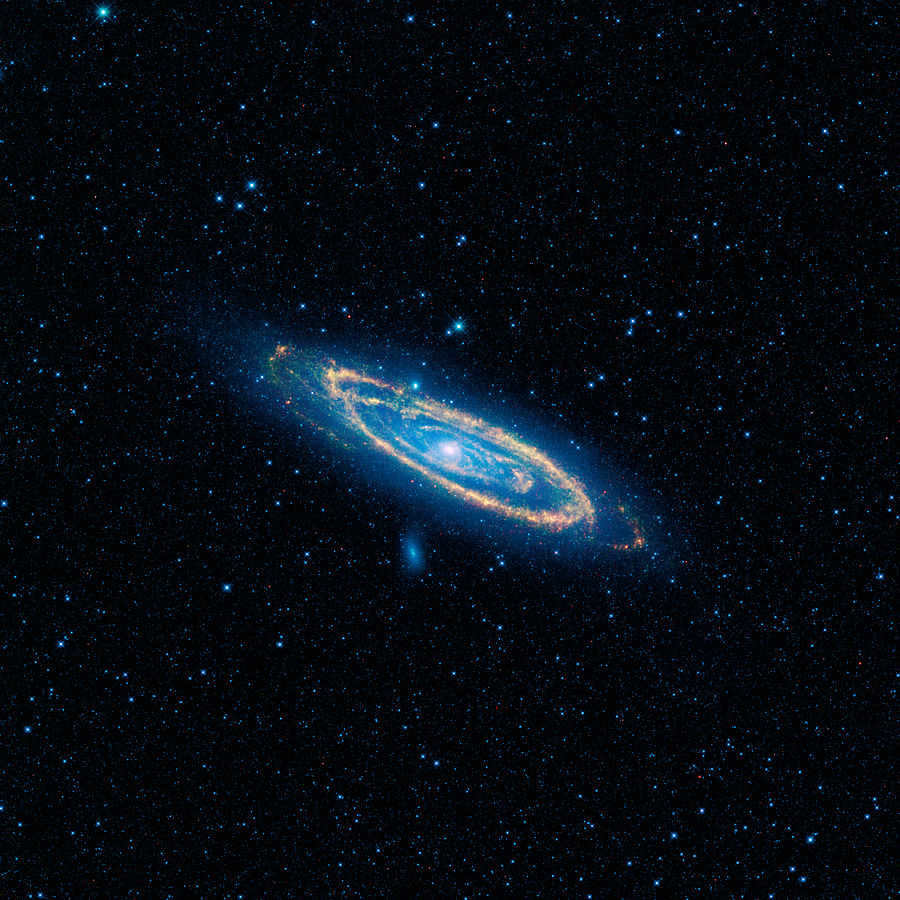
The WISE program captured an image of the Andromeda Galaxy, also known as M31.
Previously, it was believed that our own galaxy, the Milky Way, closely resembled Andromeda in terms of size and structure. However, further astronomical observations have revealed that they actually belong to different subclasses of spiral galaxies. While they share some similarities, such as their tendency to absorb dwarf satellite galaxies and their internal structure, the pattern of their arms is distinct.
However, let’s start with the basics. In order to provide a better understanding of Andromeda’s neighboring galaxy, let’s examine its key characteristics – and to avoid confusion, let’s compare them to our own galaxy’s parameters.
Galaxy Classification
According to the Hubble classification, the Andromeda Galaxy falls under the typical Sb class. This means that it resembles a spiral galaxy with its spiral arms evenly distributed around a central bulge – a luminous region filled with aging stars. On the other hand, our very own Milky Way is classified as a SBbc class galaxy – a spiral galaxy with a bar. The distinction between our “stellar island” and M31 lies in this bar, which extends from the bulge and connects it to the arms.
If you want to see for yourself what the scientists are observing, you can take a look. The image presented below is the largest and most detailed image of M31, covering the entire galaxy. It is composed of approximately 600 million pixels and has a resolution of 48327x12185px. The file size is 717.2 Mb. For the best viewing experience, it is recommended to view it in full-screen mode!
Interestingly, there is evidence suggesting that Andromeda might also possess a peculiar characteristic. This evidence was gathered during the 2MASS infrared space exploration program, which conducted a survey of the entire sky in the 2-micron wavelength range. The survey revealed that the bulge of the Andromeda Galaxy, which is normally concealed by gas-dust clouds and only detectable through infrared radiation, has a square shape. This unique feature is significant enough to classify Andromeda as an SB-class galaxy.
However, disregarding the intersection, the Andromeda Nebula possesses distinct characteristics compared to the Milky Way. The spacing between its spiral arms is wider than that of our galaxy. While not always perfectly smooth, certain arms in the MZ1 galaxy exhibit significant distortion. These distortions are remnants of a smaller galaxy that passed through the disk of Andromeda, leaving behind “pinholes.” Such occurrences are relatively frequent for our neighboring galaxy – approximately 10 billion years ago, it originated from a fusion of multiple proto-galaxies, and throughout its lifespan, it has assimilated at least three companion galaxies.
When discussing the variety of galaxies in the Universe, we previously noted that there are multiple elements that influence the size of a specific “star island”. The gas-dust and stellar disks of two galaxies may possess distinct scales and concentrations, thereby necessitating an examination of not only linear dimensions, but also the overall quantity of stars. Another crucial determinant of a galaxy’s destiny is its mass. The Andromeda Nebula galaxy surpasses our own in all three aspects, although the extent of its superiority fluctuates.
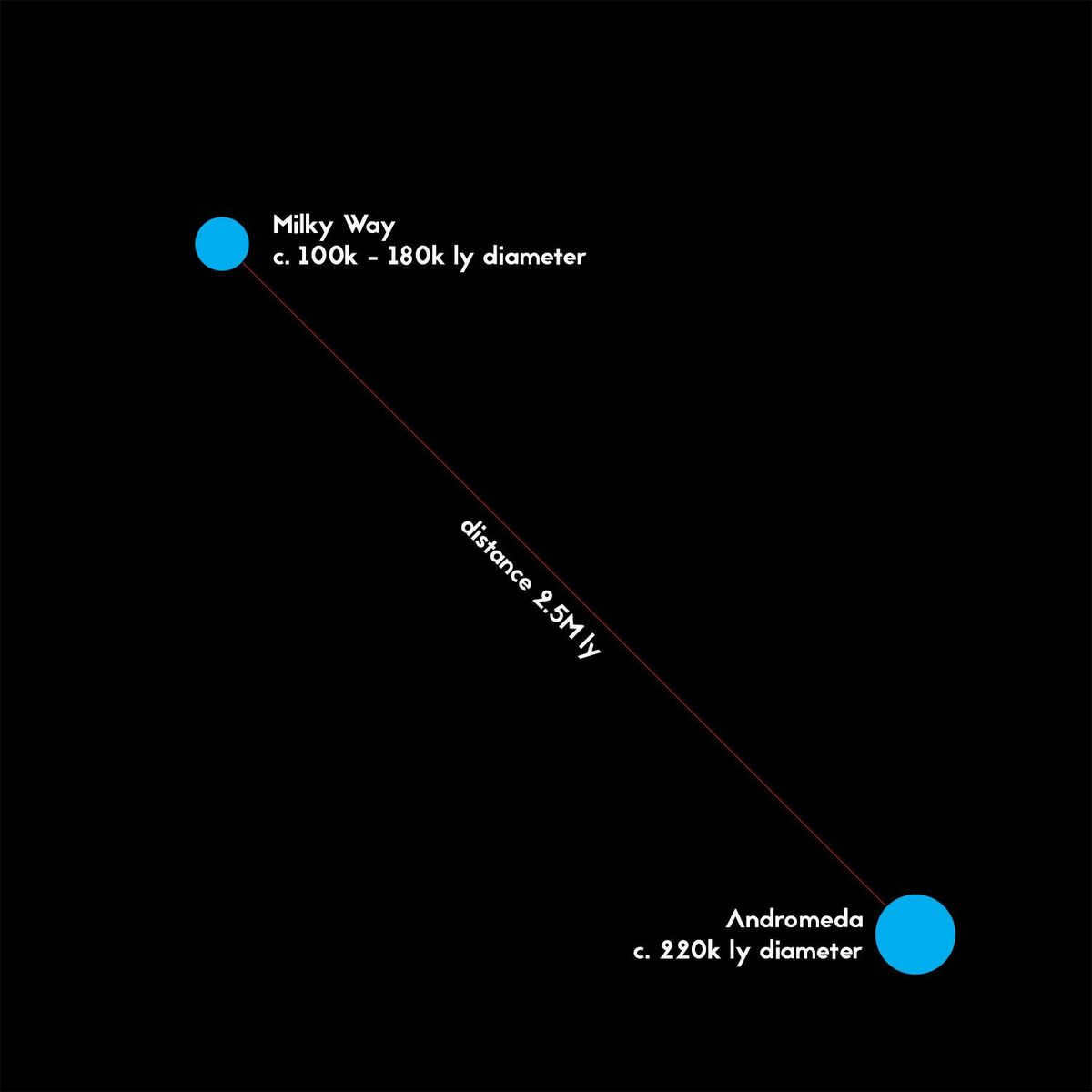

Comparison: the Milky Way, the Andromeda Galaxy, and the distance separating them
- One of the most notable and undeniable features is the size of the galaxy’s disk. In the case of M31, it stretches 110,000 light-years from its center. This is approximately four times bigger than the Milky Way, which has a more modest radius of only 26 thousand light-years. While there may be “islands of stars” that are hundreds of times larger than Andromeda, it still remains the largest within the local group of galaxies.
- Another aspect to consider is the quantity of stars present. In the case of the Andromeda galaxy, which is situated at a considerable distance and can be clearly observed, it is easier to tally them compared to our own Milky Way. The approximate count of stars in Andromeda is estimated to be around 1 trillion, which equates to 10^12 celestial bodies. It is important to note that this is a conservative estimate, as Andromeda is positioned at an angle relative to Earth, resulting in some stars from our own galaxy obstructing the view. Furthermore, even in the most detailed images, the average-sized stars only occupy 1-2 pixels. In contrast, the Milky Way is not far behind in terms of size, with current estimates putting the number of stars at around 400 billion.
- The situation is analogous when it comes to the mass of Andromeda. Given that more than 95% of the matter in any galaxy is dark matter, it is assumed that its proportion is roughly the same – thus, the mass of the galaxy should correspond to the mass of visible stars and gas. The Andromeda Galaxy has a mass of 1.5 trillion solar masses – this number, when converted to regular units, amounts to 29000000000000000000000000000000000000000000000000000000000000000000000000000000000000000000000000000000000000000000000000000000000000 kilograms! However, the Milky Way is not lagging behind its counterpart – its mass ranges from 0.8 to 1.5 trillion solar masses.
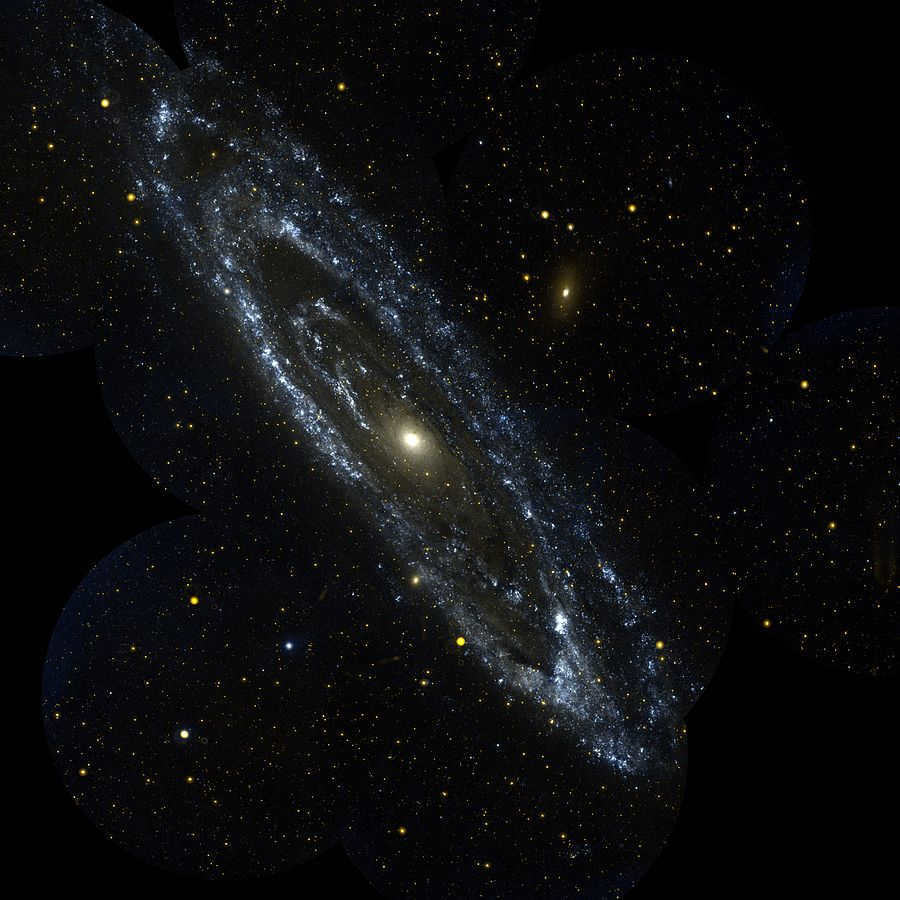

The Andromeda Galaxy captured in the ultraviolet spectrum, resulting in this stunning combined image.
At the current stage of scientific understanding, the precise measurements of various celestial bodies within the Andromeda Galaxy remain elusive. The masses of planets, stars, and asteroids can be estimated by observing their rotational patterns in relation to one another and applying the laws of gravity. However, for accurate calculations, scientists would need to observe the galaxy’s satellites over thousands of years to determine their orbits. Unfortunately, the necessary observations have not been conducted for a sufficient period of time. Consequently, astrophysicists are left with making educated assumptions based on the available data.
The movement of the galaxy and its satellites
The entire Universe is interconnected and in constant motion – this is not just a philosophical belief, but a simple deduction based on the well-established principles of gravity. The Andromeda Galaxy is no exception to this rule. Different regions of the galaxy are in motion at varying speeds. The stars and gas near the central core rotate at a velocity of 225 km/sec, while at a distance of 7,000 light years, their speed decreases to 50 km/sec. This acceleration is caused by the concentration of mass in the core, including heavy stars and a supermassive black hole, which is traditionally considered the heart of the galaxy.
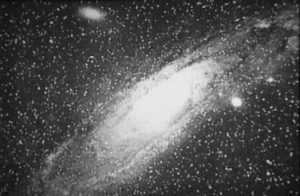

This is the primary visual representation of the Andromeda galaxy. The top region displays the presence of M110, while M32 can be seen on the right side.
In addition to other “star islands”, the Andromeda galaxy is also home to 14 dwarf satellite galaxies. Two of the largest, M32 and M110, were first discovered in the 18th century and are easily visible through a telescope. Scientists believe that M32 may have broken through the “arch” in the Andromeda’s disk. Furthermore, Andromeda regularly absorbs these satellite galaxies, with some globular clusters of stars in the halo being remnants of the absorbed galaxies’ nuclei.
Andromeda, the largest member of the Local Group of galaxies, interacts with other galaxies in various ways. In the future, around 3-4 billion years from now, it will collide and merge with our own Milky Way galaxy. While it is challenging to accurately predict the movements of such enormous objects, recent studies indicate that this collision is inevitable.
So, how will this merger occur? As the galaxies draw closer, their central nuclei will begin to orbit each other at incredibly high speeds. This gravitational interaction will cause the star disks to be disrupted and scattered, resembling splashes of water flying apart. Meanwhile, the nuclei will continue to spin faster and faster until they eventually combine to form a new, massive bulge. The resulting galaxy will have a lenticular shape, as not all the stars from the Milky Way and Andromeda will survive the violent merger, and the spiral arms will be obliterated.
Resources about the subject
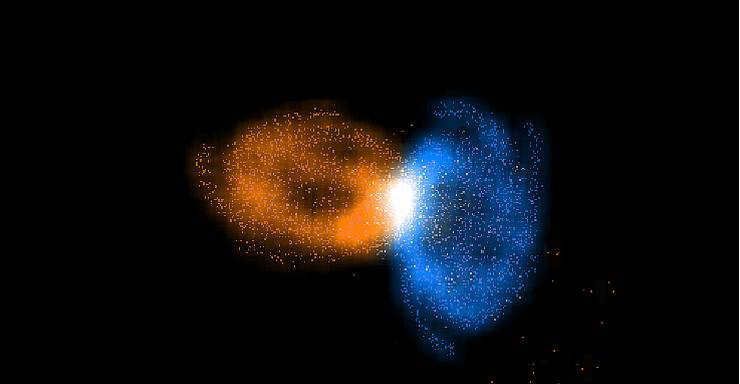
What does the future hold for our Sun and Earth? They are expected to remain untouched – the probability of stars from two galaxies colliding is extremely low. Let’s consider an illustrative analogy. If we were to shrink the Sun to the size of a table tennis ball, the Milky Way would have a diameter of 30 million kilometers. Even if we were to place the stars from both galaxies side by side, the distance between each ball would still be over 3 kilometers. Given that real stars, like the cores of galaxies, repel each other upon initial contact rather than directly colliding, the chances of these “balls” colliding are highly unlikely.
As a result, there is a high probability, close to 50%, that our Sun will embark on a galactic journey – during the merger, it will detach from the Milky Way and venture into the depths of the Universe. The orbits of the planets will remain unaffected and unchanged. However, during this time, the Earth will face the greatest peril from the Sun itself, as it will be approaching the red giant stage, the pre-death phase of its evolution.
If you found this article interesting, feel free to share it with your friends!
The Milky Way is home to billions of stars, including our own Sun. Being located within the Galaxy, astronomers have a special chance to closely observe neighboring stars and planetary systems with great accuracy. However, understanding how the Milky Way compares to other galaxies in the Universe is a challenging task. A recent study discovered that the chemical makeup of the Milky Way, as seen from faraway worlds, is uncommon but not unparalleled.
Astronomers’ understanding of the variety of systems in the Universe is rooted in the extensive observations of galaxies that are visible from Earth. With the advancements in telescopes, the range of objects available for observation has constantly expanded. Some of these objects are located nearby and can be studied in great detail, while others remain as mere bright specks or a few pixels in an image, such as the distant galaxies from the early stages of the Universe.
Astronomers have the ability to observe galaxies from different perspectives, with some being observed from the edge, others from an angle, and some with their disk plane perpendicular to Earth. By gradually piecing together these observations, they are able to reconstruct the shapes of these galaxies. Another important method is the spectral analysis of the light emitted by these galaxies, which allows astronomers to determine the chemical composition of the stars, interstellar gas, and dust that make up these distant systems.
However, mapping our Galaxy poses a significant challenge. To gain an accurate understanding of its appearance, astronomers would need to observe it from a vantage point above the galactic disk, where the Sun resides at a distance of tens of thousands of light years. The process of constructing a map of the Milky Way involves grappling with a substantial volume of gas and dust, which obstruct and scatter light from various celestial objects.
Consequently, all existing maps of our Galaxy remain ambiguous and rely heavily on assumptions. In an effort to shed light on the appearance of the Milky Way to astronomers situated beyond its borders, an international team of researchers, led by astronomers from the German Institute of Astronomy of the Max Planck Society, conducted a study to map the distribution of metals (a term used in astronomy to refer to all elements heavier than hydrogen and helium) within our Galaxy.
Chemical composition of stars and interstellar gas
Hydrogen and helium, the first two elements in the Universe, came into existence just moments after the occurrence of the Big Bang. All other elements were created much later as a consequence of nuclear reactions occurring within stars and processes connected to stellar evolution.
The most prevalent elements, like carbon and nitrogen, are produced in the cores of most stars through the fusion of lighter elements like hydrogen and helium. Heavier elements, such as iron, are produced exclusively in massive stars that conclude their life cycles in supernova explosions. The extreme conditions of these explosions result in the formation of additional elements that were only present in small, trace amounts within stars.
The spatial distribution of heavy elements within a galaxy holds critical insights into its evolutionary trajectory and historical occurrences. Furthermore, a prevailing pattern exists – the abundance of metals in the interstellar medium progressively rises over time. Stars that originated in earlier epochs exhibit lower metal content, while those born later tend to possess higher levels. By scrutinizing the chemical makeup of stars across distinct regions, it becomes feasible to discern the chronology of stellar formation.
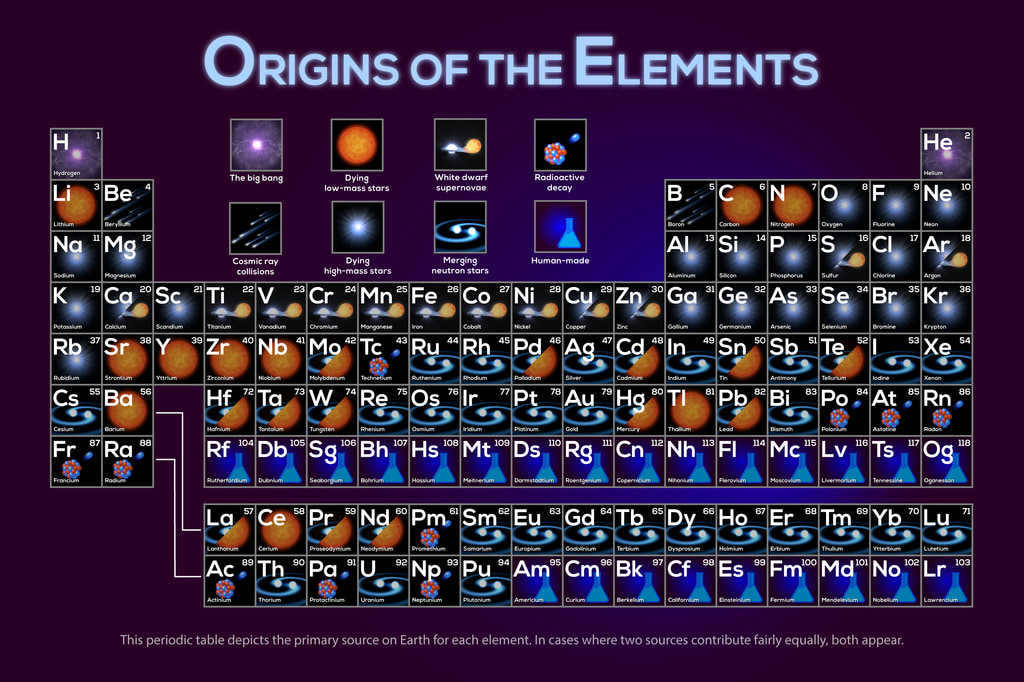
What methods did scientists employ to chart the Milky Way?
During the past decade, scientists have conducted various comprehensive star surveys to analyze specific characteristics of the stars within our galaxy. In their investigation, astronomers utilized data obtained from the Apogee survey, an extensive research project that utilizes emission spectra to gather information about the chemical composition and movement of over 100,000 stars within the Milky Way. These findings were then combined with the outcomes of the Gaia satellite survey, which tracks the position and luminosity of more than 1.5 billion stars within our galaxy, as well as numerous other celestial objects.
In order to merge the different data sets, scientists utilized the TNG50 computational simulation, which replicates and monitors the development and progression of galaxies using existing information. By comparing the findings of the simulation with Milky Way-like galaxies from the Manga survey, astronomers were able to determine the outcomes of the study.
What were the findings of the research?
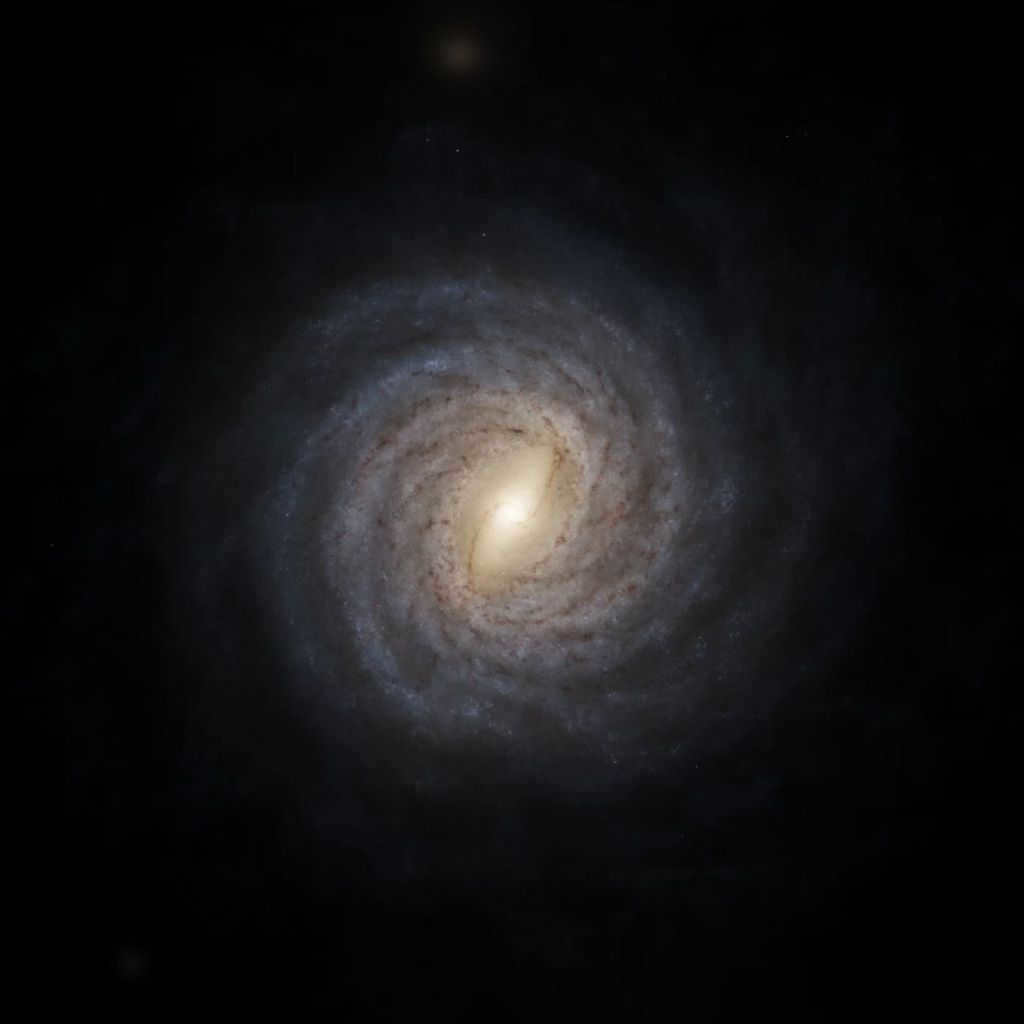
The findings revealed a non-uniform alteration in metallicity within the Milky Way. As one moves away from the core – the Sagittarius A* supermassive black hole – the abundance of elements heavier than iron gradually rises. At a distance of approximately 23,000 light years, it becomes comparable to that of the Sun (which is positioned 26 thousand light years away from the Galaxy’s core).
Interestingly, as the distance increases, the quantity of heavy elements starts to decline, decreasing by approximately threefold in comparison to the Sun’s chemical composition at a distance of around 50 thousand light-years.
Compared to surveys conducted on other galaxies or through modeling, it is quite uncommon to find a doughnut-shaped distribution of metallicity. Only 1% of galaxies that have been studied and are similar in age and structure to the Milky Way exhibit a similar distribution. However, computer modeling suggests a higher occurrence rate of 11%. This difference can be attributed to the limitations of real observation and the constraints of modeling the vastness of the Universe.
Astronomers do not currently have a definitive answer for the cause of this unusual distribution of chemical elements within the Milky Way. One hypothesis proposes that the low metallicity in the center of the Galaxy may be linked to the activity of Sagittarius A*, which has “pushed” a significant amount of gas rich in heavy elements deep into the galaxy. On the other hand, the peripheral anomaly may be a consequence of a past collision between the Milky Way and a dwarf galaxy.
Future observations focused on studying stars in the Milky Way and rare galaxies with a similar chemical element distribution will determine the validity of these hypotheses.
Learn more:
Featured image: The Milky Way in the night sky. Image by tawatchai07 on Freepik
Over the course of 10 billion years, the Milky Way has experienced numerous collisions and mergers with other galaxies. By examining globular clusters, researchers have constructed a genealogical chart for our galaxy.
Discover “Hitech” on
What is our current understanding of the Milky Way?
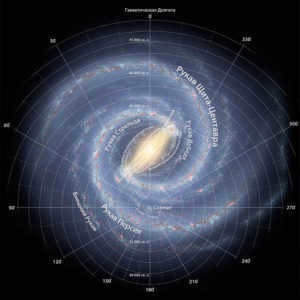
The Story of the Galaxy
A group of astronomers conducted a study on the motion of stars in the Milky Way galaxy, measuring their movement over a span of 30,000 light-years. Their findings revealed that approximately 10 billion years ago, the Milky Way merged with a much larger galaxy known as Gaia-Enceladus. This merger resulted in the formation of a thick disk and caused the Milky Way to take on a more inflated shape. Gaia-Enceladus was about 10 times smaller in size compared to the current Milky Way, but during the cataclysmic event, the ratio was 1 to 4 as the Milky Way was considerably smaller at that time. In terms of mass, Gaia-Enceladus was slightly larger than the present-day Small Magellanic Cloud. The scientists from the University of California at Riverside (USA) also calculated that 1 billion years ago, the dwarf galaxy in Kiel, the dwarf galaxy in the constellation Furnace, and several other ultra-faint dwarf galaxies were actually satellites of the Large Magellanic Cloud, not the Milky Way.
While it is possible for our Galaxy to collide with other galaxies, including the Andromeda Galaxy, making specific predictions is currently impossible due to the unknown transverse velocity of extragalactic objects.
What impact does the “family tree” have on our understanding?
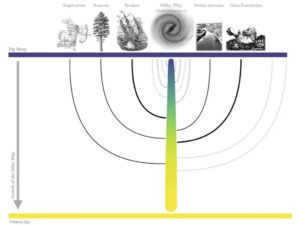
- Gaia-Enceladus (Gaia-Enceladus),
- Helmi,
- Sequoia,
- Sagittarius.
- The characteristics of the newly discovered Kraken galaxy perfectly align with the properties of the fifth group of globular clusters. Researchers assert that the absorption of this galaxy had a profound impact on the development of the Milky Way.
By analyzing data from the Gaia space telescope, the researchers classified the globular clusters according to their orbital motion. These clusters, which share similar orbits within the Milky Way, were found to have originated from the same galaxy. It is believed that these ancient galaxies merged with our own at some point in time.
Each of the five protogalaxies discussed in the study had a mass of at least 60 million times that of the Sun. The authors of the study suggest that there may have been at least ten galaxies with masses exceeding 4.5 million solar masses that were captured.
What lies ahead for the Milky Way?
Based on research published in September 2014, it is predicted that the Milky Way will undergo some significant changes in the future. According to one model, in approximately 4 billion years, our galaxy will merge with the Large and Small Magellanic Clouds, absorbing them into its mass. Furthermore, in 5 billion years, the Milky Way itself will be engulfed by the Andromeda Nebula. Another calculation suggests that the collision between these two galaxies will occur tangentially around 4.5 billion years from now.
Related Articles
According to modern astrophysicists, the Milky Way is classified as a spiral galaxy with a bulge. Located in the central region, there is a thickening known as a bulge, which spans approximately 8000 parsecs. It is highly likely that a supermassive black hole with a mass of 4.3*10^6 solar masses resides at the center, accompanied by a medium-sized black hole in orbit. At the core of the black hole lies a radio source named Sagittarius A, exerting gravitational influence on the neighboring stars’ trajectories.
The Milky Way galaxy is home to around 400 billion stars, with varying estimates ranging from 100-200 million to 100-400 billion. Its radius measures approximately 50,000 light years, while its thickness is around 30,000 light years (although some sources suggest a thinner value of 1,000 light years). The center of the galaxy lies within the constellation Sagittarius. It takes about 200 million years (though other figures like 180, 216, or 250 million years are also mentioned) for the galaxy to complete a full revolution around its center, possibly due to the movement of arms or density waves.
The total mass of the galaxy is estimated to be 3×10^12 solar masses, equivalent to 6×10^42 kg (as of January 2009). Interestingly, most of this mass is not in the form of stars or interstellar gas, but rather in a non-luminous halo of dark matter.
The Milky Way galaxy is a member of the Local Group of galaxies, which is part of the Virgo Supergroup with a size of approximately 200 million light-years (1.89*10 24 m) and a mass of 2-10 45 kg. The largest entity in this supergroup is the Virgo Cluster. The primary galaxies in the Local Group include the Andromeda Nebula (TA), the Milky Way (MF) galaxy, the Triangle Galaxy (GT), and the Large and Small Magellanic Clouds galaxies (BMO and MMO).
Highlighted sections about the Milky Way galaxy:
- The structure and dynamics of the Milky Way
- Local Cluster of Stars and Local Group of Stars
- Local Bubble
- The position and trajectory of the Solar System in the Galaxy
- Companion Nebulae of our Galaxy
- Alien Galaxies
- Magellanic clouds – satellites or aliens?
Structure and Dynamics of the Milky Way
Anatomy and physiology of our galaxy.
Spiral structure of the Milky Way
Are spiral arms the “annual rings” of galaxies?
The spiral structure of our Milky Way galaxy is not well understood and is a fascinating subject for scientific research. It consists of at least 5 spiral arms (listed from the center to the outer edge):
- The Swan arm,
- The Centauri arm (Shield-Centaurus),
- The Sagittarius arm,
- Orion arm [the shortest],
- The Perseus arm [does it continue to the Swan River?].
The arms are named after their respective constellations.
The Milky Way’s arms are made up of population I stars, including our Sun, as well as other objects such as young stars, H II regions, and dispersed star clusters.
The destiny of the Milky Way
Over the next four billion years, the Milky Way is expected to engulf its satellite galaxies, namely the Large and Small Magellanic Clouds. In five billion years, after absorbing all the smaller objects, the Milky Way and the Andromeda Nebula will start to merge.
Within a time frame of fewer than eight billion years, the Sun is predicted to exit the main sequence, experiencing a substantial growth in its dimensions by a factor of approximately 300. During this period, it is anticipated that the Earth will either be engulfed by the expanding star or undergo a transformation into a desolate, arid celestial body devoid of an atmospheric envelope. The subsequent conclusion of the red giant phase will involve the Sun shedding its outer layers, resulting in the creation of a planetary nebula. At the core of this nebula, a white dwarf with the dimensions comparable to the present-day Earth will be situated.
Fast-moving currents in the Milky Way
Astronomers postulate that there could be billions of planets silently coursing through our Milky Way galaxy, detached from any stars. Furthermore, they are aware of around twenty-four stars swiftly escaping from our galaxy, and even a whole star cluster fleeing from the colossal galaxy M87. These entities share a common thread – they were all once “ejected” from their original abodes due to gravitational disruptions. Russian astronomers Igor Chilingaryan and Ivan Zolotukhin from Moscow State University’s GAISH have demonstrated that entire galaxies can also be expelled from their surroundings into intergalactic space.
Latest Updates on Our Galaxy (Milky Way)
Exploring the Local Star Cluster and Group
The solar system is part of a fascinating local group of stars, which in turn belongs to the Local Cluster of Stars, commonly known as the Gould Belt. Each of these star systems has its unique center of rotation.
The Gould Belt, also referred to as the Gould Belt Local Cluster, is an assemblage of young and massive stars with an age range of 10-30 million years. These stars are arranged in a disk-like structure that spans a diameter of 500-1000 parsecs. The center of this belt is approximately 150-250 parsecs away from the Sun, in the direction opposite to the center of our galaxy. It was named after Benjamin Gould, who first observed in 1879 that bright stars in the sky form a belt inclined at an angle of 15-20 degrees to the plane of the Milky Way.
Exploring the Origins of X-rays in Space
Understanding the Phenomenon behind X-ray Emission
The Local Bubble, an irregularly shaped expanse of rarefied hot gas spanning over 300 light-years, currently lies within the path of our solar system’s movement.
Traditionally, X-rays detected in outer space were attributed to the presence of the Local Bubble and the solar wind. The Local Bubble refers to a cluster of sparsely distributed, heated gas located in the Orion arm of our Milky Way galaxy. Meanwhile, the solar wind represents a continuous stream of highly ionized particles emanating from the sun’s corona and dispersing into the surrounding space at speeds reaching up to 1200 km/s.
However, recent investigations supported by NASA have uncovered a surprising revelation – approximately 60% of the observed X-rays in space originate from an unidentified source, currently unexplained by scientific understanding.
The location and path of the Solar System within the Milky Way
The position of the Solar System within the Milky Way
The current location of the solar system is within the relatively small Local Arm, also known as the Orion Arm. This arm is approximately 3,500 light-years thick and about 10,000 light-years long. The Orion Arm is connected to two larger arms, the inner arm of Sagittarius and the outer arm of Perseus.
Our Sun is located about 26,000 light-years away from the center of the Milky Way galaxy (according to other data, it is approximately two-thirds of the galaxy’s radius). This would equate to a distance of approximately 2.4956 x 10^20 meters. The Sun orbits around the center of the Milky Way at a velocity of 220 to 230 km/s. The direction of this velocity vector is towards the constellation of the Swan.
Each astronomer has their own way of measuring. To address this, in 1963, the astronomical community reached a consensus on standardized values for two key factors that determine the size of the Galaxy (R0) and the velocity of its rotation in the Sun’s orbit (V0). These values were set at R0=10 kpc and V0=250 km/s. However, in 1985, the General Assembly of the International Astronomical Union recommended new values: R0=8.5 kpc and V0=220 km/s. Some astronomers, though, dispute the accuracy of these new values compared to the old ones. Every year, three or four research papers are published on the topic, with results varying between 7 and 11 kpc.
Moreover, the solar system also exhibits its own peculiar motion amidst the stars of the galaxy. The Sun’s peculiar velocity amounts to approximately 19 km/s and is directed towards the constellations Lyra and Hercules.
The trajectory of the Solar System within the Milky Way
Does our planetary system traverse the arms of the Galaxy?
According to one hypothesis, the solar system traverses the arms of the galaxy, including Centauri, Sagittarius, Orion, and Perseus during its semi-circular movement (as depicted in the figure above). Furthermore, it not only crosses the Sagittarius arm, but also moves along it for a certain period of time. On the other hand, another theory suggests that such crossings occur three times at equal intervals, passing through the arms of Perseus, Shield (Centaurus), and Sagittarius (as illustrated in the left figure).
It is possible that approximately 70 million years ago, the Solar System intersected with the Sagittarius or Centaurus arm, leading to the Dinosaurs being covered by planetesimals. Therefore, in another 130 million years, we will once again cross that arm.
One theory suggests that glaciations on Earth may be caused by the movement of our planetary system through the arms of the Milky Way, specifically the highly catastrophic Shield (Centauri) arm:
- Jurassic Global Glaciation (140 million years ago) [Is there any evidence for this?] – Centauri arm. [There is no confirmed evidence of widespread glaciation during the Jurassic period. If there were any traces of Jurassic glaciation, they would likely be found in the area currently occupied by the Antarctic ice sheet, as East Antarctica was located in the most northerly position during that time].
- Carboniferous global glaciation (280 million years ago) – Sagittarius Arm
- Vendian global glaciation (570 million years ago) – Centaurus arm.
- The Centaurus arm experienced a glaciation event during the Neoproterozoic period, approximately 790 million years ago.
- The Centaurus arm also witnessed the Huronian glaciation, which occurred around 1000 million years ago. This glaciation event is not to be confused with the Gneissian glaciation, which took place 2400 million years ago.
- The Centaurus arm was affected by the Timiskamingian glaciation, an early Proterozoic glaciation event that occurred approximately 1200 million years ago. This glaciation is also known as the Swedish Tilloids glaciation.
- The Paleoproterozoic glaciation, which occurred around 1650 million years ago, also impacted the Centaurus arm.
- The Sagittarius arm experienced the Rias glaciation around 2000 million years ago.
- The Sagittarius arm also witnessed the Neoarchean glaciation, which occurred approximately 2650 million years ago.
Additionally, there is evidence suggesting that the Solar System is located near a region known as the corotation circle. This region is where the Keplerian velocity of stars and the motion of density waves (arms) align. As a result, the Sun and Earth do not significantly cross these arms, providing some protection against potentially harmful radiation from the arms and supernova events.
“Within the proximity of the Sun, it is plausible to observe segments of two spiral tendrils, situated approximately 3 thousand light years away from us. These segments are referred to as the Sagittarius arm and the Perseus arm, based on the constellations in which they are detected. The Sun is positioned nearly equidistant between these spiral tendrils. However, in close proximity to us, within the Orion constellation, there exists another, slightly less distinct tendril, which is regarded as a branch of one of the primary spiral arms within our Galaxy.”
The distance from the Sun to the center of the galaxy spans an impressive range of 23,000 to 28,000 light years. This indicates that our Sun is positioned somewhere in the middle, between the bustling hub of the galaxy and its outer edge. Alongside its neighboring stars, the Sun gracefully orbits the galaxy’s center, maintaining a steadfast pace of 200-220 km/s, completing a full revolution approximately every 200 million years. Consequently, throughout its entire existence, Earth has completed no more than a mere 30 revolutions around the galaxy’s center.
The velocity of the Sun’s rotation around the Galactic center is nearly identical to the velocity at which the compression wave moves in this area, creating the spiral arm. This is a rather unique situation for the Galaxy, as the spiral arms typically rotate at a consistent angular speed, resembling the spokes of a wheel, whereas the motion of stars follows a different pattern. As a result, the majority of stars in the disk continuously enter and exit the spiral branches.
- Is the position of the solar system in the Galaxy unique? L. S. Marochnik. The journal “Nature” No. 6 for 1982, pp. 24-30. 2 ideas based on the unusual composition of plutonium and iodine isotopes in the Solar System.
Possible variations in the Solar orbit
The orbit of the Sun around the center of the Galaxy also undergoes oscillations: every 33 million years it crosses the galactic equator, then moves above its plane to a distance of 230 light-years and then returns to the equator. [The accuracy of this information has not been verified, it could be someone’s speculation, but what is intriguing is this: 33 million years – a geological cycle of riftogenesis and the Earth’s radiation cycle.]
Here is some additional information from the book “Geocosmos” by V.Golubev. P. Golubev describes the motion of the solar system along an elliptical orbit. This model, proposed by the prominent astronomer P.P. Parenago in the 1950s, is more compatible with geology. The total orbital period is approximately 212 million years. The anomalistic period, which is the time it takes for the solar system to pass through the perigalactium, is about 176 million years. The next passage of the perigalactium is expected to occur in 12 million years, while the last passage of the apogalactium happened 76 million years ago. The draconic half-period, which represents the time it takes for the solar system to pass the opposite nodes of its orbit and the oscillation of the solar system relative to the plane of the Galaxy, is estimated to be around 88 million years. The distance from the center of the Galaxy in perigalactia, apogalactia, and on average is 7.12, 8.59, and 7.86 thousand pc respectively. The eccentricity of the orbit is 0.09. The linear velocity reaches 250 km/s in perigalactia and 207 km/s in apogalactia. The orbital inclination is +1.37°. According to other astrophysical models, the total period of rotation ranges from 165 to 260 million years, with an average of 200 to 220 million years.
Finally, let’s reference authoritative information from Bart Bock’s book “The Milky Way”. The Sun’s movement differs slightly from the circular rotation of the galaxy in its vicinity. We can envision the Sun as traversing an ellipse with a small degree of eccentricity while simultaneously executing gradual oscillations that run perpendicular to the galactic plane.. It appears to consistently stay within 200 parsecs of the galactic plane and completes 2-3 oscillations perpendicular to the galactic plane. 2-3 oscillations in the perpendicular direction over a span of 250 million years. In other words, this occurs during a complete revolution around the Galaxy’s center. (p. 147)
The Galactic Year and the Galactic Paradigm
According to the calculations of Parenago, it was determined that the Sun’s orbit is nearly circular and its periods of motion, including the sideric, anomalistic, and draconic periods, last approximately 212, 176, and 85 million years respectively.
There are varying beliefs about the duration of the galactic year, with some suggesting it lasts 176 million years, while others propose figures of 212, 216, or even 250 million years. Traditional school astronomy textbooks often cite a figure of 180-200 million years, but newer books on astronomy suggest figures of 230-240 million years. Furthermore, the study of the geochronological scale indicates a value of 185-190 million years, according to the author’s opinion.
Let’s perform the calculation ourselves. The orbital velocity of the Sun is approximately 220 km/s, and the distance from the Sun to the center of the Galaxy is about 8 kpc: 8 x 3.09-10 16 km? – approximately 2.5-10 20? . Therefore, the orbital period 2πR/v = 6.28 x 2.5-10 20 / 22-10 4 – we obtain approximately 7-10 15 s or around 200 million years.
A more precise calculation is T = 2 x 3.1416 x 8 x 3.08568-10 19 / 2.2-10 5 = 7.05016-10 15 . There are 365.24219 days in a sidereal year – so T = 7.05016-10 15 / (365.24219 * 24 * 3600) = 223.4-10 6 years. However, it is uncertain whether the Galaxy has been rotating at the same speed (and in a constant orbit) for hundreds of millions of years.
Galactic Nebulae Satellites
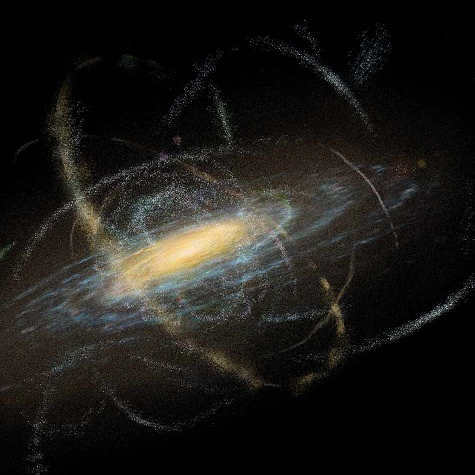 | 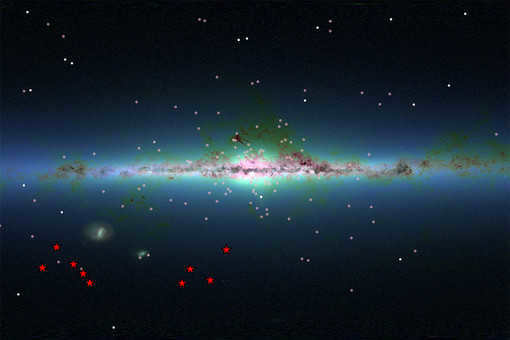 |
The Milky Way galaxy has around eighteen satellites. Notable among them are the Large and Small Magellanic clouds, which are not technically satellites but rather passing neighbors. The other satellites are less prominent and not as bright.
- Sculptor
- Furnace
- Leo (2 dwarf galaxies)
- Dragon
- the Little Dipper
- Sectarian
- Keel
- Sagittarius
- the Big Dog
- Big Dipper [dwarf spheroidal galaxy, located 100 kpc away – ranked 11th or 13th with BMO and MMO], and so on.
There are also objects that are considered “controversial”. Our Galaxy, along with the Andromeda Nebula and several others, forms a local group of galaxies. The masses of the Andromeda Nebula and the Milky Way are similar, so there are objects that cannot be attributed to either center.
Currently, the Milky Way has approximately 50 satellite galaxies, and one of the largest among them is a dwarf elliptical galaxy located in Sagittarius. This galaxy is of great interest to researchers for two main reasons. Firstly, it is very close to Earth, being only 70,000 light years away. Secondly, it may play a role in the formation of the Milky Way’s arms.
- Russian astronomers have made a groundbreaking discovery by identifying nine previously unknown satellites orbiting the Milky Way.
- By analyzing data, astronomers have successfully determined the precise location of an imperceptible satellite, known as “Galaxy X,” as it follows a parabolic trajectory around the Milky Way. Presently, it is situated approximately 300,000 light-years away from the galactic center.
- The Milky Way has absorbed numerous smaller galaxies, transforming them into dispersed streams of stars that gradually merge with the native population.
- New evidence suggests that the Milky Way has been involved in the act of stellar theft.
Galaxies are like fellow travelers, traversing the same path, meeting, and engaging in cosmic collisions.
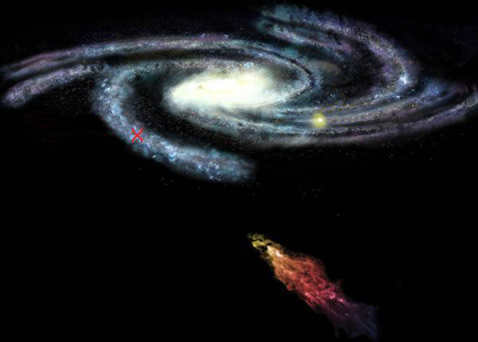 |
- Scientists have made a prediction about a future collision between the Milky Way and another galaxy. The Smith cloud, which contains a significant amount of metal-deficient neutral and ionized gas (primarily hydrogen), is currently moving towards the Milky Way and is expected to collide with it in approximately 27 million years. This cloud has already interacted with the Milky Way’s disk once, possibly around 70 million years ago (coinciding with the extinction of the dinosaurs), suggesting a recurring pattern of interaction every 100 million years.
Are the Magellanic clouds satellites or extraterrestrial beings?
It is possible that the Magellanic Clouds are not satellites of the Galaxy, but rather alien entities passing by.
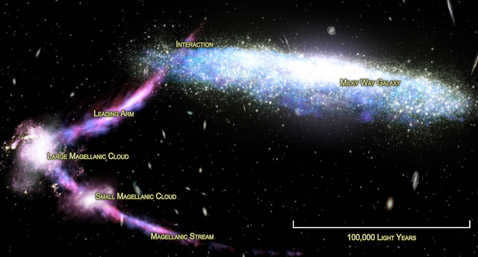 |
The Large Magellanic Cloud (LMC)
The Large Magellanic Cloud (LMC) is a dwarf galaxy of SBm type that is situated approximately 50 kiloparsecs away from our own galaxy, the Milky Way (located in the constellation Goldfish). The LMC has a diameter that is about 20 times smaller than the Milky Way and is home to around 5 billion stars, which is approximately 1/20th of the number of stars in our galaxy. The mass of the LMC is roughly 300 times less than that of the Milky Way, with a mass of 10^10 solar masses. Despite its smaller size, the LMC is still the fourth most massive galaxy in the Local Group, ranking behind M31, the Milky Way, and M33.
- The Magellanic clouds have extended their reach into the Milky Way. A massive stream of hydrogen has been detected emanating from the Magellanic clouds and penetrating the plane of our galaxy. This extraordinary outflow (HVC306-2+230) collides with the Milky Way at a distance of 70,000 light-years from our solar system. In the night sky, the area of this celestial encounter can be found approximately in the Southern Cross constellation.
The SMC – A Unique Celestial Phenomenon
The Small Magellanic Cloud (SMC) is an extraordinary sight in the night sky. With a meager population of only 1.5 billion stars, this celestial marvel is located approximately 60 kiloparsecs away in the constellation Tucana. When observed, it presents itself as a faintly glowing cloud spanning about 3° in size.
For those seeking commercial opportunities, we provide a designated space for advertising links. Please refer to our terms and conditions for more information.
When searching for information about our very own Milky Way Galaxy and its surrounding satellites, consider these relevant keywords: “Our galaxy, Milky Way, Large and Small Magellanic Cloud, Galactic satellites, BMO, Local cluster, Local group of stars, Local Bubble” in Russian. In English, the primary focus is on “Galaxy” and “Milky Way.”
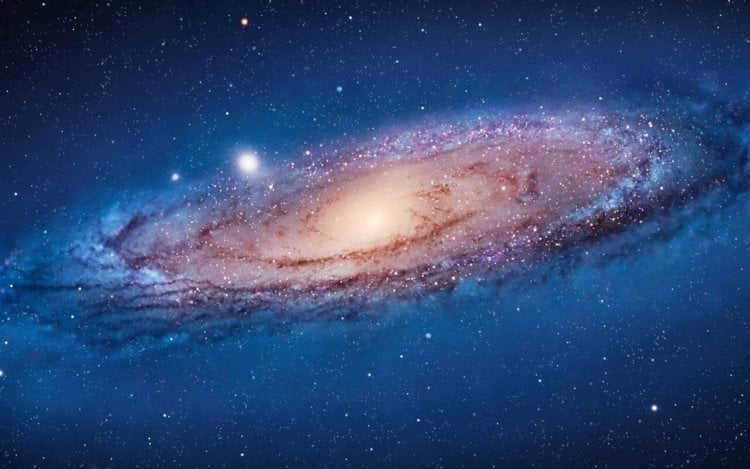
The Milky Way’s closest neighboring galaxy is Andromeda, which is also referred to as Messier 31 or M31.

M31, also referred to as Messier 31, is a galaxy that was named after Charles Messier, a renowned French astronomer. Messier included M31 in his well-known catalog, which contained numerous celestial objects found in the Northern Hemisphere. However, not all of the objects listed in the catalog were actually discovered by Messier himself.
In 1757, the scientist embarked on a quest to locate Halley’s Comet, but his calculations led him astray in determining the exact coordinates. However, during his observations at the same site, he stumbled upon a nebula, marking the first entry in his catalog known as M1 (or the Crab Nebula). Interestingly, this nebula had already been spotted by the English astronomer John Bevis in 1731. Another object, referred to as M31, was included in Messier’s catalog in 1767. By the end of that year, a total of 38 new objects had been documented. By 1781, the catalog boasted a count of 103 objects, with 40 of them being personally discovered by Messier.
The name of this celestial body was derived from the constellation Andromeda
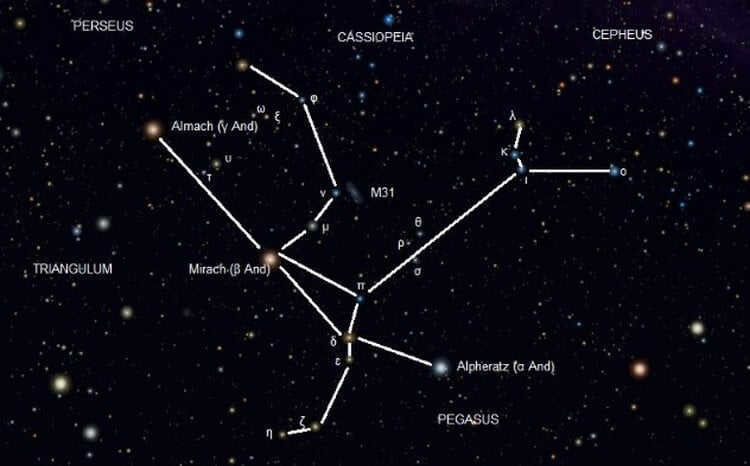
One of the most renowned star groupings in the night sky is the Andromeda constellation. It can be observed between the Big Square asterism and the star α Cassiopeia, which is located at the second lower corner of the Cassiopeia constellation when seen in the shape of the letter W. Legend has it that Princess Andromeda, the wife of the Greek hero Perseus, was transformed into a constellation following her demise. This constellation was initially documented in Claudius Ptolemy’s Almagest catalog of the celestial sphere. The other stars within this constellation, including Perseus, Cassiopeia, Cetus, and Cepheus, were also named after characters from this captivating myth.
The Andromeda constellation is host to a variety of other entities. Situated outside the galactic plane, it does not include any Milky Way clusters or nebulae. However, it does feature other observable galaxies, one of which being the Andromeda galaxy.
It surpasses the size of the Milky Way
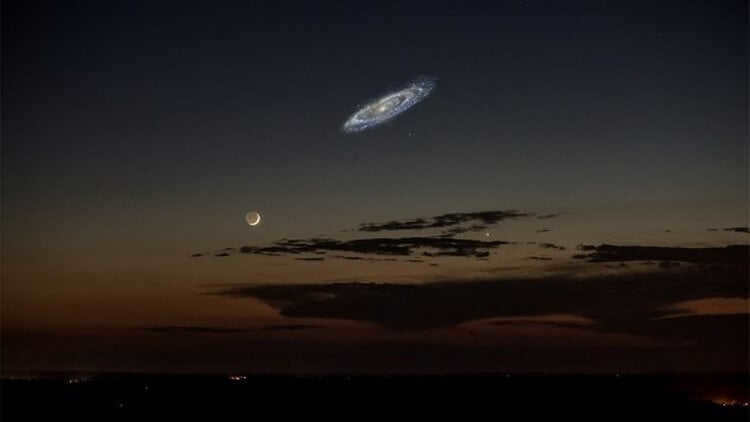
Andromeda exceeds the size of our galaxy by a significant margin.
In the field of astronomy, the term light-year is commonly employed to ascertain the distance to specific celestial objects, although certain astronomers prefer to utilize the term parsec. When it comes to extremely vast distances, the term kiloparsec, which is equivalent to 1,000 parsecs, is employed, as well as megaparsec, which is equal to 1 million parsecs. The span of the Milky Way is approximately 100,000 light-years, or 30 kiloparsecs. At first glance, this might appear to be an immense distance, but in reality, compared to other galaxies, our own appears rather diminutive.
The Andromeda galaxy boasts a diameter of around 220,000 light-years, making it over twice as large as the Milky Way. This colossal size solidifies its position as the largest galaxy within the local group. In the event that the Andromeda Galaxy emitted even more radiant light, it could potentially appear larger than the Moon when gazing at the night sky, despite being significantly farther away. Speaking of distance, this celestial entity finds its home roughly 9.5 trillion kilometers away from Earth (let’s not forget that the Moon, on the other hand, is a mere 384,000 kilometers away).
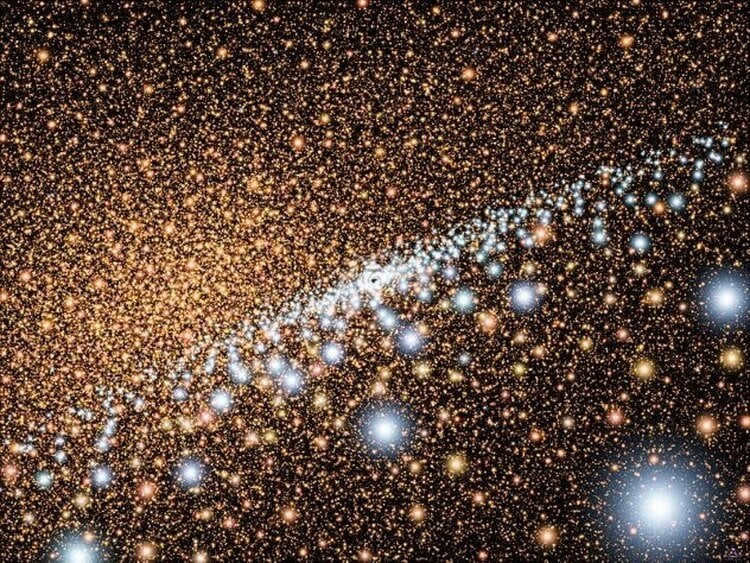
The Andromeda galaxy is home to an incredibly vast number of stars.
According to rough estimates, the Milky Way could potentially have anywhere between 100 billion and 400 billion stars. However, this pales in comparison to Andromeda, which is believed to host approximately one trillion stars. Thanks to the Hubble Space Telescope, scientists have discovered a highly abundant and rare population of hot and luminous stars within this trillion-star galaxy.
Normally, hot, young stars appear blue in color. However, the blue stars discovered in the Andromeda Galaxy appear more like mature, Sun-like stars that have depleted their inner layers and unveiled their hot blue cores. These stars are scattered throughout the galaxy’s central region and emit their brightest light in the ultraviolet spectrum.
It possesses a dual nucleus
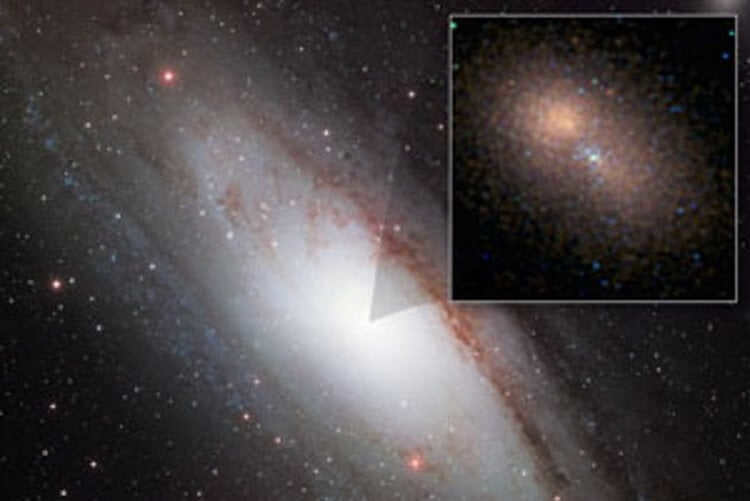
Another intriguing detail regarding the Andromeda galaxy is its unique feature of possessing a double nucleus. Scientific observations have revealed the presence of two luminous objects (P1 and P2) situated in the central region of the galaxy, with a mere 5 light-year gap between them. Each of these objects consists of numerous densely packed young blue stars.
Subsequent research conducted by astronomers has unveiled that the two nuclei do not represent two distinct star clusters, but rather a singular cluster resembling the shape of a bagel, along with a supermassive black hole that surpasses a mass of 140 million times that of the Sun. The stars within the P1 cluster exhibit a close orbital relationship with the black hole, similar to the planets orbiting the Sun, thus generating the phenomenon of a double nucleus.
Our galaxy is on a collision course
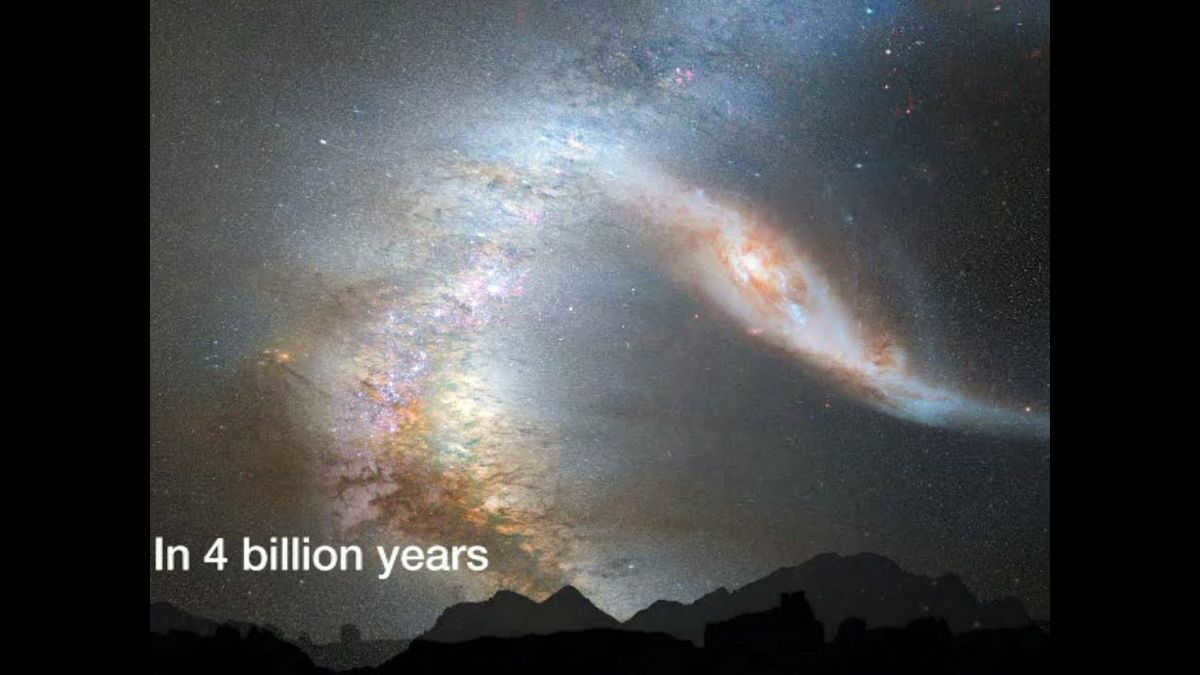
A cosmic catastrophe awaits us. Currently, the Andromeda galaxy is hurtling towards the Milky Way at an astonishing speed of 400,000 kilometers per hour. This is equivalent to circling the Earth in just six minutes. Scientists predict that in approximately 3.75 billion years, the Milky Way and Andromeda will experience a cataclysmic collision. The aftermath of this collision is still a mystery, leaving us to wonder what fate awaits our beloved planet, Earth.
Scientists are confident that despite the magnitude of this cosmic event, the Earth will endure. Alongside the rest of the solar system. Experts speculate that our planet will largely remain unscathed by this encounter between galaxies, as both have ample open space. Nonetheless, this event promises to be a captivating spectacle from Earth (assuming, of course, that life still exists here at that time). The two galaxies will be drawn towards each other until their central black holes ultimately merge into one. Once this occurs, our solar system will become a part of an entirely new galaxy – an elliptical galaxy. Unless the Sun engulfs the Earth in approximately 5 billion years, every night on our planet will be illuminated brightly, courtesy of numerous new stars. Instead of the familiar streak of Milky Way light, we will witness a more spherical source of illumination.
The absolute magnitude of this object is measured to be 3.4.
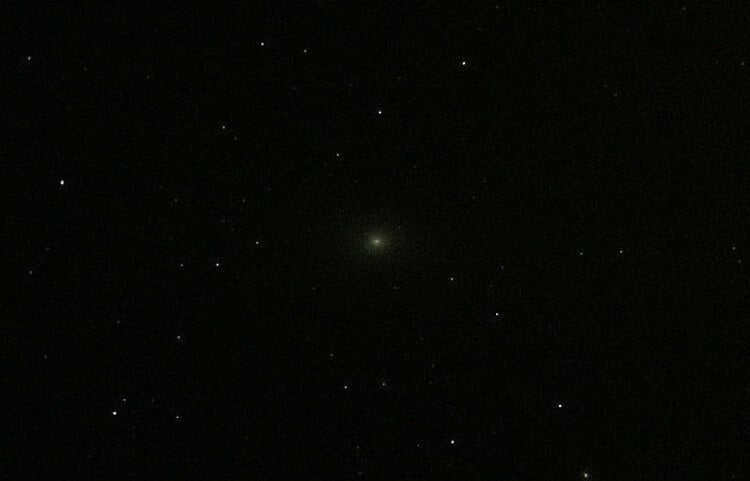
Astronomy utilizes the concept of absolute magnitude to determine the luminosity of celestial objects, enabling us to assess their brightness regardless of their distance from us.
With an absolute magnitude of 3.4, the Andromeda Galaxy stands out as the most brilliant entity in the Messier catalog. It even becomes visible to the naked eye on a moonless night. However, it is important to note that only the central region of the galaxy is observable without aid. It appears as a faint star to the unaided eye, resembling a small elliptical cloud when observed through binoculars. With the use of a large telescope, it can appear up to six times larger than the Moon.
There is an abundance of black holes
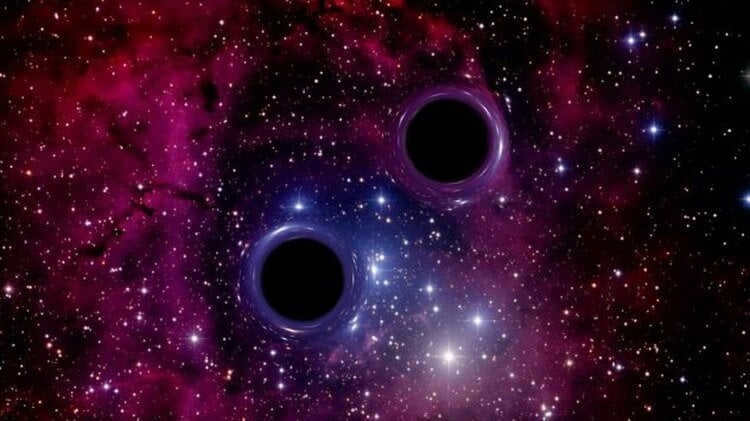
In 2013, the number of black holes in the Andromeda galaxy increased from 9 to 35. Astronomers have recently discovered 26 potential black holes, making it one of the most densely populated galaxies with these celestial objects. The majority of these newly discovered black holes have masses ranging from 5 to 10 times that of our Sun. Additionally, there are seven black holes located approximately 1,000 light-years away from the center of the galaxy.
It consists of 450 globular clusters
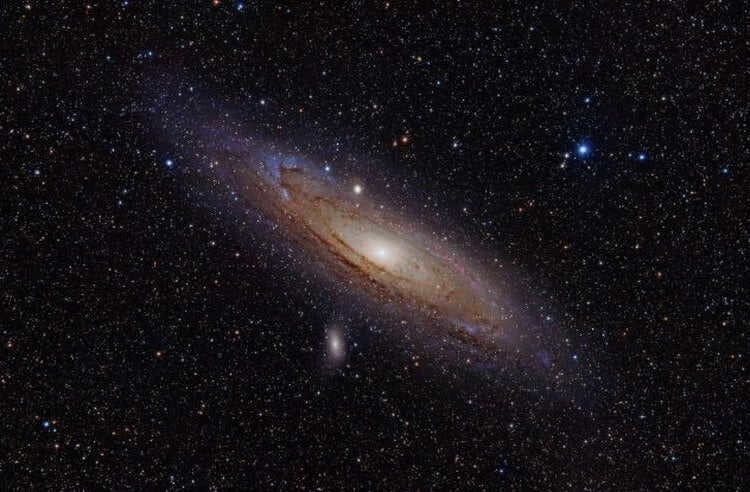
Globular clusters are compact groups of ancient stars that are gravitationally bound. They can consist of hundreds of thousands or even millions of stars. Globular clusters play a crucial role in determining the age of the universe and often aid in locating the center of a galaxy. The Milky Way is home to at least 200 globular clusters, while Andromeda boasts approximately 450.
The number of globular clusters in Andromeda may be significantly higher, but our understanding of the outer regions of this galaxy remains limited. If the globular clusters in the Andromeda galaxy were similar in size to those in the Milky Way, their total count could range from 700 to 2800.
Previously, the Andromeda galaxy was believed to be a nebula
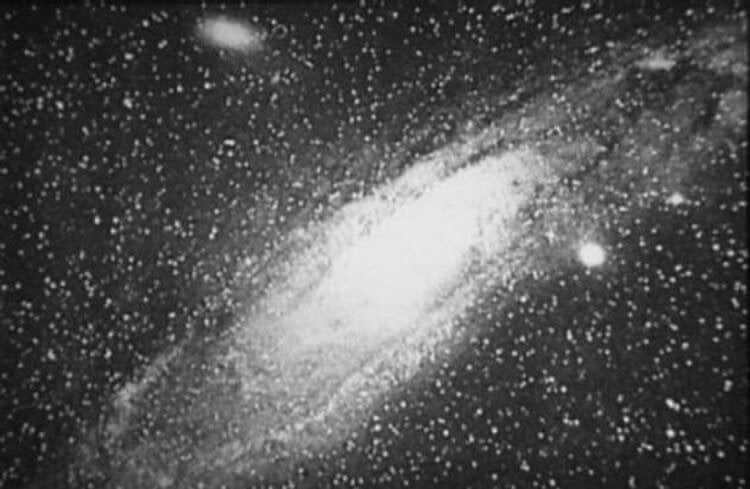

Nebulae are vast accumulations of gas, dust, hydrogen, helium, and plasma where new stars are formed. These immense clusters have often been misidentified as very distant galaxies. In 1924, the astronomer Edwin Hubble revealed that the spiral Andromeda Nebula is, in fact, a galaxy, and the Milky Way is not the sole galaxy in the cosmos.





